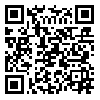Volume 77, Issue 12 (March 2020)
Tehran Univ Med J 2020, 77(12): 786-790 |
Back to browse issues page
Download citation:
BibTeX | RIS | EndNote | Medlars | ProCite | Reference Manager | RefWorks
Send citation to:



BibTeX | RIS | EndNote | Medlars | ProCite | Reference Manager | RefWorks
Send citation to:
Sheykhhasan M, Bakhtiari Pak H, Bakhtiari Pak M, Kalhor N. Evaluation of sticky bone efficacy to reconstruction of human jaw bone resorption and defects: case report. Tehran Univ Med J 2020; 77 (12) :786-790
URL: http://tumj.tums.ac.ir/article-1-10221-en.html
URL: http://tumj.tums.ac.ir/article-1-10221-en.html
1- Research Center for Molecular Medicine, Hamadan University of Medical Sciences, Hamadan, Iran. Department of Mesenchymal Stem Cell, the Academic Center for Education, Culture and Research, Qom, Iran.
2- Department of Implantology, Faculty of Dentistry, Grigore T. Popa University of Medicine and Pharmacy, Iași, Romania. ,hosseinbakhtiaripak
3- Department of Implantology, Faculty of Dentistry, Grigore T. Popa University of Medicine and Pharmacy, Iași, Romania.
4- Department of Mesenchymal Stem Cell, the Academic Center for Education, Culture and Research, Qom, Iran.
2- Department of Implantology, Faculty of Dentistry, Grigore T. Popa University of Medicine and Pharmacy, Iași, Romania. ,
3- Department of Implantology, Faculty of Dentistry, Grigore T. Popa University of Medicine and Pharmacy, Iași, Romania.
4- Department of Mesenchymal Stem Cell, the Academic Center for Education, Culture and Research, Qom, Iran.
Abstract: (2761 Views)
Background: One of the most significant factors in the success of dental implant procedures, can be mentioned by the quality and quantity of jaw bone. The occurrence of some problems such as trauma, infection, pathological lesions and the long-term absence of teeth in patients, it causes irregularities in the jaw bone and can get bone resorption. Sever defects after trauma or tumor resection needs bone reconstruction. Sticky bone is a new biological agent that provides stabilization of bone graft in the defect, and therefore, ameliorates tissue repairing and decreases bone loss during healing period. In this study, the evaluation of sticky bone performance to reconstruction of defects in two patients jaw's bone was considered.
Case Presentation: Two patients (1 male, 1 female) with an average age of 50 years underwent surgery, due to the history of tooth extraction. They had resorption of jaw bone for implant surgery. The teeth were 11 and 37. This study was performed in Al-Mortaza's Clinic, Qom province, Iran, from May 2016 to January 2017. 10 ml of blood were taken individually and centrifuged at 1300 revolutions per minute (rpm) for 8 minutes to separate the platelet-rich fibrin. Then, platelet-rich fibrin was combined with allogeneic bone to form sticky bone. Sticky bone prepared during implant surgery, with implant inside the patient's jaw bone was used.
Conclusion: The use of sticky bone to stimulate and induce bone resorption in toothless area was associated with increased implant's success. Sticky bone due to multiple growth factors, such as TGF-β1 and VEGF, usability is an appropriate and efficiency method for stimulation of bone resorption.
Case Presentation: Two patients (1 male, 1 female) with an average age of 50 years underwent surgery, due to the history of tooth extraction. They had resorption of jaw bone for implant surgery. The teeth were 11 and 37. This study was performed in Al-Mortaza's Clinic, Qom province, Iran, from May 2016 to January 2017. 10 ml of blood were taken individually and centrifuged at 1300 revolutions per minute (rpm) for 8 minutes to separate the platelet-rich fibrin. Then, platelet-rich fibrin was combined with allogeneic bone to form sticky bone. Sticky bone prepared during implant surgery, with implant inside the patient's jaw bone was used.
Conclusion: The use of sticky bone to stimulate and induce bone resorption in toothless area was associated with increased implant's success. Sticky bone due to multiple growth factors, such as TGF-β1 and VEGF, usability is an appropriate and efficiency method for stimulation of bone resorption.
Keywords: case reports, depleted bone, dental implants, platelet-rich fibrin, reconstructive surgical procedures, sticky bone
Type of Study: Case Report |
Send email to the article author
| Rights and permissions | |
 |
This work is licensed under a Creative Commons Attribution-NonCommercial 4.0 International License. |





